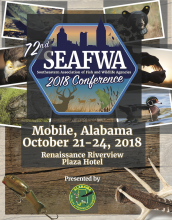Variation in White-tailed Deer Antler Size: The Effects of Age, Landscape Composition, and Physiographic Province
Spatial variation in landscape composition can influence phenotypic expression in wildlife species and can improve management efforts to express certain phenotypic traits. We evaluated the influence of age, landscape composition, and physiographic province on white-tailed deer (Odo- coileus virginianus) antler characteristics using data from 16,622 male deer (age range: 1.5–3.5+ years old) harvested between 1997–2016 across five physiographic provinces in Georgia. Age and physiographic province influenced antler size index (ASI; P < 0.001). ASI of yearling males was greatest (x- = 53.37...
